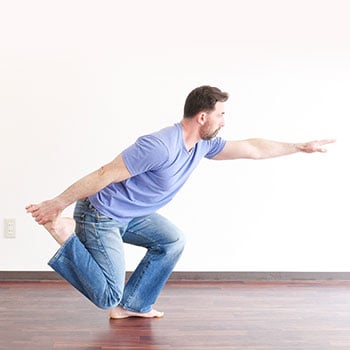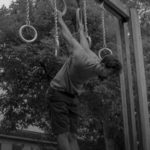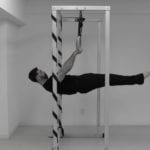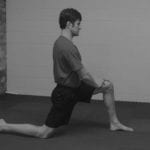Why would we want to train on gymnastic rings?
Gymnasts certainly look strong when we watch them every four years in the Olympics, but do us non-gymnast folk get any benefit from them?
We can use a lot more weight on gym machines, dumbells, and barbells. Doesn’t that mean it’s better? It’s much more difficult to do even simple movements on the gymnastic rings.
 But that’s a feature not a bug. Training on the rings requires a blend of coordination and control that is unique and valuable. It develops a practical and meaningful strength.
But that’s a feature not a bug. Training on the rings requires a blend of coordination and control that is unique and valuable. It develops a practical and meaningful strength.
Ok, but isn’t it dangerous? Is it worth the risk?
In this article we’ll talk about how training on the rings can benefit your fitness and life, as well as the risks involved and what you can do to lessen them. It’s a cliche’ to say “everyone is different,” but all these details provide a better understanding of what will be best for you and your goals.
Rings to Reality: Building Practical Strength for Real Life
 When we think about strength training, heavy weights and specialized machines usually come to mind.
When we think about strength training, heavy weights and specialized machines usually come to mind.
And it’s true, their use is undeniable for the promise of raw power. When something is specifically made to be pulled/pushed/lifted, and you are stable and secure, it allows for the use of a maximal amount of weight. That’s not bad at all!
Raising the “ceiling” of your strength can be a great thing, but it’s certainly not the only way to build strength and arguably it’s not the best way that translates into the strength we need in real life.
When we introduce gymnastic ring work to clients the common reaction is surprise! Surprise at how difficult it is to do even fundamental movements like push-ups and dips. Exercises they can do with ease on the solid ground. Even the burliest laugh at themselves when they shake uncontrollably with just one repetition!
Is Unstable Strength a Better Strength?
 The unstable nature of free swinging gymnastic rings gives a dynamic challenge totally distinct from weight machines and barbell training. It’s this unique wobbliness that changes those basic exercises (push-ups, dips, pull-ups) into more comprehensive total body movements. It’s not so much that the so-called “stabilizer” muscles are being called upon – that’s not a real thing – it’s that to keep yourself steady and perform a movement you automatically have to be more focused.
The unstable nature of free swinging gymnastic rings gives a dynamic challenge totally distinct from weight machines and barbell training. It’s this unique wobbliness that changes those basic exercises (push-ups, dips, pull-ups) into more comprehensive total body movements. It’s not so much that the so-called “stabilizer” muscles are being called upon – that’s not a real thing – it’s that to keep yourself steady and perform a movement you automatically have to be more focused.
Mindfulness is baked into the training, you simply won’t be able to do it if you’re distracted.
So while this style of strength building likely won’t allow you to express your power at that maximal level, it does enhance your overall body “connections”, building improved coordination and balance along with strength. The things we need to lift and move in daily life seldom offer the predictable stability of gym equipment. The adaptability and strength developed through ring training echo the variable, often unpredictable physical tasks outside the gym, from lifting a toddler to navigating a crowded space with agility.
Graceful Resilience: The Unseen Strength
 So with the above in mind, you can see that this style of strength development is much more than pushing up ever increasing weight. It’s the concurrent development of poise and grace along with physical development.
So with the above in mind, you can see that this style of strength development is much more than pushing up ever increasing weight. It’s the concurrent development of poise and grace along with physical development.
The need for quick shifts in action to keep balance while performing the complex movements fosters mental resilience and focus. This mental aspect translates into a heightened awareness of your body’s movements and capabilities, which can’t help but translate into your daily life.
Many clients tell us (with pleasant surprise!) that they feel a sense of increased preparedness and confidence. The emphasis on mastering control over your body in various positions, is also incredibly satisfying and motivating. Skill development is both fun and effective in changing our physical fitness.
Ultimately, incorporating gymnastic rings into your training routine is part of a holistic approach ensuring that the strength you build is not only impressive in its capacity but also immediately applicable to the varied and unpredictable nature of our everyday lives.
Maximize The Benefits, Minimize The Risks

Weighing the risks and benefits of any activity comes down to YOUR strengths/weaknesses and YOUR needs.
What about the risks? Is training on the rings too risky for whatever benefits they can bring?
Well I like to think of it as more of a spectrum than an either/or thing. There is an inherent scale of how risky an action is for you in that moment.
Some are more risky than others of course – jumping out of a moving car is not a great idea and neither is kicking a hornet’s nest.
These are very obvious situations of risky activities and might not seem relevant to exercise. But looking more specifically at these examples, what if the car was moving at one mile an hour? Or the nest was old and not full of hornets? Then you’d say that wasn’t as dangerous.
Proper decision making requires context.
In my training as a healthcare provider, I was taught about Absolute Contraindications. These are when interventions shouldn’t be done for the patient. Examples include medicine combinations that can be deadly, or full weight-bearing after fracture repairs.
Then there are Precautions, in which the risk to benefit of your intervention is a judgement choice. You look at the risks and the benefits, and make the best decision with the information at hand.
Understanding Your Body: The Key To Success
You can see that we’d like to approach the choice of which exercises and activities would work best for you based on a critical analysis of your own particular strengths and weaknesses. An honest assessment of the aspects of your physical capacity will do more for you than simply ascribing an exercise or tool as “good” or “bad.”
As we discussed in this previous post, good form on an exercise is dependent upon your physical structure and your particular ability in the various movements.
How Strong Do You Need To Be Right Away for Gymnastic Rings Training?
 One common – and pretty reasonable concern- is whether training on the rings is “bad for the shoulders”.
One common – and pretty reasonable concern- is whether training on the rings is “bad for the shoulders”.
You may hear that the increased range of motion brings particular risk to shoulder ligaments and other soft tissue.
And yes it is. If you are not strong enough to handle that range of motion.
But just as in any other exercise activity, why would you think it’d be good to perform a variation that you are not capable of doing safely? Opponents of the ring dip seem to think that there is only one way to do it, with full body weight at the extreme stretch position at the bottom.
But even to a novice, it’s clear that you can adjust your performance of it by reducing the range of motion and your bodyweight by lowering the rings (or standing on a sturdy elevated surface) and adjusting the force through your legs.
The same goes with push-ups, pull-ups, and various other exercises on the rings or suspension device. Any of these exercises can be adjusted as needed to fit your current level of strength.
Challenges Provide Opportunities
One of the relative difficulties with bodyweight training exercise in contrast to weight training is that an incremental progression of force and stress requires more forethought and concentration. But that’s not a drawback, just like we’ve said above, it’s benefit if it encourages you to be more mindful of your training.
So let’s reframe this all and make the cautionary factor about whether or not you can appropriately scale and adjust the ring exercises to your current strength level. This may require some thoughtful planning if you are designing your own routine.
It simply makes sense that you should begin and progress at the proper point dependent upon your capabilities. Then why should ring training exercises be any different than acknowledging that you shouldn’t squat with 500 pounds on the bar if you aren’t ready for it, but squatting with your bodyweight or just the bar is just fine?
How Flexible Do You Need to Be to Start Gymnastic Rings Training?
 Another, and in my opinion a more relevant, concern for most people is whether your current flexibility allows you to train safely on the rings.
Another, and in my opinion a more relevant, concern for most people is whether your current flexibility allows you to train safely on the rings.
A lot of people have tight shoulders, especially if your work requires you to be at a desk for most of the day. “Use it or lose it” is simply the truth.
A lack of flexibility then becomes quite an issue for those positions on the rings that require not just normal flexibility levels but ranges that go beyond that of an average person.
Movements such as the “skin the cat,” the transition point of the muscle-up, and the bottom position of the dip, can be too much if you are dealing with decreased range of motion. Add in a strength deficit and now the ring training naysayers’ concerns become more credible.
But again this implies that you will be just jumping into the exercise with no heed to your own senses. As if you would blindly follow GPS directions and turn into a lake because that’s what it’s telling you to do.
I want to believe that we are all smarter than that.
How to Address the Flexibility Challenges of Rings Training
If you know you have shoulder issues, begin a good flexibility regimen to address those concerns, this post on shoulder mobility is a good start. This doesn’t mean you should do only stretching and aren’t allowed to do any ring work. Instead, work on the rings with exercises that are appropriate for you.
Work on exercises such as the Top Position hold, pull-ups, tuck hangs, push-ups (and yes even dips) in a shorter range of motion, and a dozen other such movements where you are in a range of motion that’s best for you.
Apply your own sense of what you can safely do on the rings. You know what you can do, so you should do it!
The Specific Concern of Elbow Tendonitis
 Along with tight shoulders, another common question is in regards to how to “protect” against tendonitis (medial or lateral). Should we all be doing months of specific work before even touching the rings?
Along with tight shoulders, another common question is in regards to how to “protect” against tendonitis (medial or lateral). Should we all be doing months of specific work before even touching the rings?
I think you can guess by now that I don’t believe that’s necessary. The primary cause of a tendonitis is a repetitive strain that outpaces our soft tissue’s recovery ability. As we’ve talked about above, this is a direct relationship to your strength levels and the amount of work you are able to perform.
It’s not that the tool is the problem, it’s the improper use of the tool that’s the problem. It’s a physical capacity issue that can happen whether you use gymnastic rings, a bar, a machine, or any other gadget.
And it often happens when you get stuck in a rigid and uncompromising regimen that requires the same arbitrary sets and repetitions and hold times for everyone. A much better strategy – with much more sense! – includes auto-regulation. This allows you to train consistently and well with less strain and overuse.
In my experience, the trouble begins when people ignore the obvious issue that there is a difference between “normal” people and those that have and are able to dedicate several hours a day to training. So when a person with real life responsibilities and time constraints attempts to follow the program designed for a very different kind of athlete, it shouldn’t be a surprise when injury eventually occurs.
Rather than forcing yourself into that square hole, doesn’t it make more sense to tailor the training to you and not the other way around? If you already know your elbows may be vulnerable, or you’d like to get ahead of it, read this post for an overview of the contributing factors to elbow strain and how to avoid and address them.
Skill Over Equipment: Why Method Matters Most
 Lastly there’s an issue that will affect likely 90% of people who first try the rings, and that is the shaking and wobbling like you’re in a hurricane. Unless you have some experience with a similar type of training stimulus, exercise on the rings is utterly unique and requires a bit of time to increase your comfort level and literal stability on the equipment.
Lastly there’s an issue that will affect likely 90% of people who first try the rings, and that is the shaking and wobbling like you’re in a hurricane. Unless you have some experience with a similar type of training stimulus, exercise on the rings is utterly unique and requires a bit of time to increase your comfort level and literal stability on the equipment.
Once more, a lack of control only means that you should approach the exercises in a thoughtful way and temper your progression. When you start on ring training, work with lower count repetitions. End well shy of “failure” and keep the quality of your exercise performance as high as you can.
Choose and adjust the exercises so that you can end the repetitions at any point safely and you’ll be able to continue practicing and improving your control on the rings. This will minimize the risks and also keep you gaining strength and flexibility as well as control.
One of the keys is to not seek fatigue when you train this way.
You may certainly get that tiredness but that’s a side effect, it’s not the point! It may seem weird to do at first, but this is one of the main concepts that make this type of training so effective. And give you increased strength that is meaningful for you.
You can make these changes right away in whatever you’re doing now, but if you’d rather start on a proven program, Integral Strength has both “Equipment” and “No Equipment” versions that will help you build meaningful and connected full body strength.





